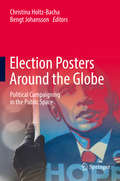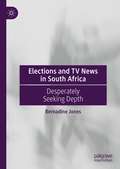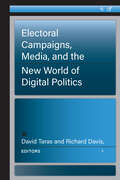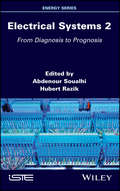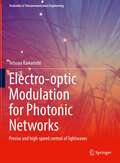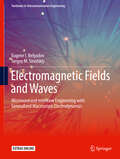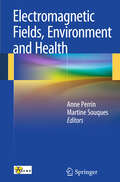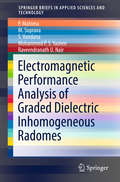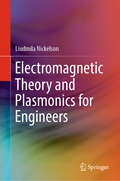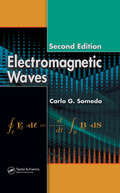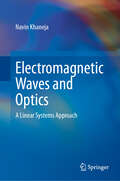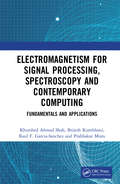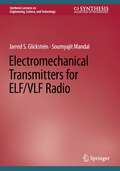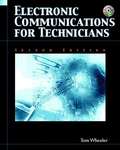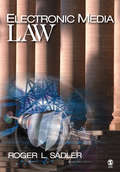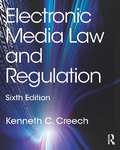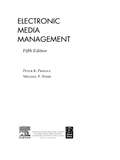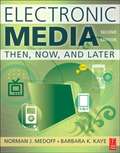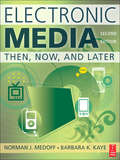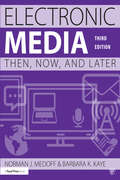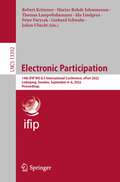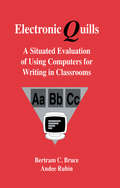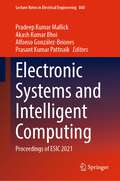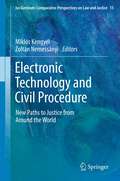- Table View
- List View
Election Posters Around the Globe
by Christina Holtz-Bacha Bengt JohanssonThis book examines the history and role of election posters as one of the most crucial forms of political communication, especially in electoral campaigns, in a number of countries around the globe. The contributing authors present comparative research on electoral posters from countries from all five continents, summarizing international similarities and national differences. The book also discusses theoretical aspects and different methodological approaches that are used for studying the design, content and reception of election posters as a means of political communication.
Elections and TV News in South Africa: Desperately Seeking Depth
by Bernadine JonesThis book takes television news seriously. Over the course of nine chapters, Elections and TV News in South Africa shows how six democratic South African general elections, 1994–2019, were represented on both local and international news broadcasts. It reveals the shifting narratives about South African democracy, coupled with changing and challenging political journalism practices. The book is organised in three parts: the first contains a history of South African democracy and an overview of the South African media environment. The second part is a visual analysis of the South African elections on television news, exploring portrayals of violence, security, power, and populism, and how these fit into normative news values and the ruling party’s tightening grip on the media. The final part is a conclusion, a call to action, and a suggestion to improve political journalistic practice.
Electoral Campaigns, Media, and the New World of Digital Politics
by Richard Davis David TarasToday, political leaders and candidates for office must campaign in a multimedia world through traditional forums—newspapers, radio, and television—as well as new digital media, particularly social media. Electoral Campaigns, Media, and the New World of Digital Politics chronicles how Twitter, Facebook, Reddit, email, and memes are used successfully and unsuccessfully to influence elections. Each of these platforms have different affordances and reach various audiences in different ways. Campaigns often have to wage different campaigns on each of these mediums. In some instances, they are crucial in altering coverage in the mainstream media. In others, digital media remains underutilized and undeveloped. As has always been the case in politics, outcomes that depend on economic and social conditions often dictate people’s readiness for certain messages. However, the method and content of those messages has changed with great consequences for the health and future of democracy. This book answers several questions: How do candidates/parties reach audiences that are preoccupied, inattentive, amorphous, and bombarded with so many other messages? How do they cope with the speed of media reporting in a continuous news cycle that demands instantaneous responses? How has media fragmentation altered the campaign styles and content of campaign communication, and general campaign discourse? Finally and most critically, what does this mean for how democracies function?
Electoral Politics in Sri Lanka: Presidential Elections, Manipulation and Democracy (Europa Country Perspectives)
by S. I. KeethaponcalanThis volume examines and analyses electoral politics in Sri Lanka through the theoretical framework of manipulation. The following questions guided the study: how do political actors manipulate elections, and what are the salient features of electoral politics in Sri Lanka? Primary and secondary data formed the basis of the analysis, examining eight presidential elections. The research findings indicated that Sri Lankan governments, political parties and political leaders have taken advantage of six types of electoral manipulation, including constitutional tinkering, field fixing, time fixing, vote suppression, process manipulation and resource manipulation. Through a close examination of eight presidential elections, research carried out for the volume found that elections are often associated with violence; presidential elections are mainly a majoritarian affair in which minority communities play only a marginal role; there is a significant gender imbalance, as women’s participation in the electoral process is very limited; despite the presence of a large number of candidates contesting the election, it always remains a two-way race; and amid extensive manipulation and other problems, voter participation tends to be high. This volume will be a valuable resource for students, academics and researchers who focus on democracy, good governance, electoral studies and South Asian politics and history, and will enhance the conceptual foundation of democracy advocates and activists.
Electrical Systems 2: From Diagnosis to Prognosis
by Hubert Razik Abdenour SoualhiMethods of diagnosis and prognosis play a key role in the reliability and safety of industrial systems. Failure diagnosis requires the use of suitable sensors, which provide signals that are processed to monitor features (health indicators) for defects. These features are required to distinguish between operating states, in order to inform the operator of the severity level, or even the type, of a failure. Prognosis is defined as the estimation of a system's lifespan, including how long remains and how long has passed. It also encompasses the prediction of impending failures. This is a challenge that many researchers are currently trying to address. Electrical Systems, a book in two volumes, informs readers of the theoretical solutions to this problem, and the results obtained in several laboratories in France, Spain and further afield. To this end, many researchers from the scientific community have contributed to this book to share their research results.
Electro-optic Modulation for Photonic Networks: Precise and high-speed control of lightwaves (Textbooks in Telecommunication Engineering)
by Tetsuya KawanishiThis textbook provides comprehensive and detailed information on electro-optic modulation, which plays important roles in lightwave networks including optical fiber links, visible ray communications, fiber-wireless, etc. The first part of this book describes roles and basic functions of optical modulators as well as various modulation schemes. The second part is on mathematical expressions dedicated to optical modulation, where sideband generation are clearly described. In conclusion, this book provides useful information for device and system technologies, and helps in understanding fundamental issues on telecommunication systems as well as electro-optic devices. Contents in this book provide valuable information for engineering students in telecommunications. It also gives useful examples of applied mathematics using Bessel functions. It is ideal for upper undergraduate and graduate level classes.Provides comprehensive mathematical expressions dedicated to optical phase modulation based electro-optic effect;Presents practical knowledge of optical modulators as well as basic theory on modulator operation;Includes classroom materials including software and PowerPoint slides for easy integration into curriculum.
Electromagnetic Fields and Waves: Microwave and mmWave Engineering with Generalized Macroscopic Electrodynamics (Textbooks in Telecommunication Engineering)
by Sergey M. Smolskiy Eugene I. NefyodovThis textbook is intended for a course in electromagnetism for upper undergraduate and graduate students. The main concepts and laws of classical macroscopic electrodynamics and initial information about generalized laws of modern electromagnetics are discussed, explaining some paradoxes of the modern theory. The reader then gets acquainted with electrodynamics methods of field analysis on the basis of wave equation solution. Emission physics are considered using an example of the Huygens-Fresnel-Kirchhoff canonic principle. The representation about strict electrodynamics task statement on the base of Maxwell equations, boundary conditions, emission conditions and the condition on the edge is given. Different classes of approximate boundary conditions are presented, which essentially simplify understanding of process physics. The canonic Fresnel functions are given and their generalization on the case of anisotropic impedance. The free waves in closed waveguides and in strip-slotted and edge-dielectric transmission lines are described. A large number of Mathcad programs for illustration of field patterns and its properties in different guiding structures are provided. The material is organized for self-study as well as classroom use.
Electromagnetic Fields, Environment and Health
by Anne Perrin Martine SouquesA good number of misconceptions are currently circulating on the effects of non-ionizing radiations on our health, which can lead to an oversimplification of the issue, to potentially dangerous assumptions or to misleading data analysis. Health effects may be exaggerated, or on the contrary underplayed. The authors of this work (doctors, engineers and researchers) have endeavored to supply validated and easily understandable scientific information on the electromagnetic fields and their biological and health effects. After a general review of the physics of the waves and a presentation of non-ionizing radiations, the authors review the main emission sources encountered in our daily environment. They summarize simply but as accurately as possible the current knowledge on their biological effects. The safety limits recommended by international organizations are presented for the different frequency ranges. This book is intended for doctors, teachers, scientists, students, policy makers and anyone else interested in a deeper understanding of the health effects of electromagnetic fields. Intended to serve a broad readership, everyone will approach it according to their respective level of curiosity and knowledge. It is neither an exhaustive inventory of all the studies made to date, nor a survey text focusing only on some chosen studies. Nor is the objective to present all the sources of non-ionizing radiations. Interested readers will be given the opportunity to broaden their knowledge, also by consulting the selected bibliography presented by the authors at the end of each chapter.
Electromagnetic Performance Analysis of Graded Dielectric Inhomogeneous Radomes (SpringerBriefs in Applied Sciences and Technology)
by Raveendranath U. Nair P. Mahima M. Suprava S. Vandana Mohammed P.S. YazeenThis book reports on a new radome wall configuration based on an inhomogeneous planar layer, which overcomes current fabrication constraints in radome design and yields improved electromagnetic (EM) characteristics. The book also includes a detailed description of radomes and antenna-radome interaction studies for different radome wall configurations. The radome wall was designed using the equivalent transmission line method (EQTLM), since it requires less computational speed and provides accurate results. In order to substantiate the accuracy of the results obtained using EQTLM, the simulated results based on full wave methods like CST Microwave Studio Suite are also included. The EM performance analysis of the antenna-radome system for two radome shapes, tangent ogive (for airborne applications) and hemispherical (for ground-based applications), was performed using Geometric Optics Method in conjunction with the Aperture Integration Method. To show the efficacy of the new design, a comparison of performance characteristics between the novel radome and conventional wall configurations is also included. Lastly, it presents antenna-radome interaction studies for various aperture distributions. The book offers a unique resource for all researchers working in the area of microwave radomes.
Electromagnetic Theory and Plasmonics for Engineers
by Liudmila NickelsonThis book presents the theory of electromagnetic (EM) waves for upper undergraduate, graduate and PhD-level students in engineering. It focuses on physics and microwave theory based on Maxwell’s equations and the boundary conditions important for studying the operation of waveguides and resonators in a wide frequency range, namely, from approx. 10**9 to 10**16 hertz. The author also highlights various current topics in EM field theory, such as plasmonic (comprising a noble metal) waveguides and analyses of attenuations by filled waveguide dielectrics or semiconductors and also by conducting waveguide walls. Featuring a wide variety of illustrations, the book presents the calculated and schematic distributions of EM fields and currents in waveguides and resonators. Further, test questions are presented at the end of each chapter.
Electromagnetic Waves (Second Edition)
by Carlo G. SomedaAdapted from a successful and thoroughly field-tested Italian text, the first edition of Electromagnetic Waves was very well received. Its broad, integrated coverage of electromagnetic waves and their applications forms the cornerstone on which the author based this second edition. <P><P>Working from Maxwell's equations to applications in optical communications and photonics, Electromagnetic Waves, Second Edition forges a link between basic physics and real-life problems in wave propagation and radiation. <P><P>Accomplished researcher and educator Carlo G. Someda uses a modern approach to the subject. Unlike other books in the field, it surveys all major areas of electromagnetic waves in a single treatment. <P><P>The book begins with a detailed treatment of the mathematics of Maxwell's equations. It follows with a discussion of polarization, delves into propagation in various media, devotes four chapters to guided propagation, links the concepts to practical applications, and concludes with radiation, diffraction, coherence, and radiation statistics. <P><P>This edition features many new and reworked problems, updated references and suggestions for further reading, a completely revised appendix on Bessel functions, and new definitions such as antenna effective height. <P><P>Illustrating the concepts with examples in every chapter, Electromagnetic Waves, Second Edition is an ideal introduction for those new to the field as well as a convenient reference for seasoned professionals.
Electromagnetic Waves and Optics: A Linear Systems Approach
by Navin KhanejaThe book explores electromagnetic (EM) waves, which are present everywhere—from radio, television, and cell phones to satellite dishes, antennas, and WiFi. The propagation of EM waves is governed by Maxwell's equations. When these waves pass through a medium, they slow down and refract, while in a metallic medium, they are reflected. Metallic boxes and pipes can store and direct EM waves, known as cavities and waveguides. Oscillating currents generate and transmit EM waves through antennas, allowing for long-distance communication after the waves propagate. Since oscillating currents emit EM waves, the author uses coaxial cables and transmission lines to reduce radiation and carry high-frequency currents efficiently. EM waves at very high frequencies in the optical range are responsible for transmitting visual information. The author also discusses lenses and optical instruments like telescopes and microscopes, which are used to magnify optical signals. Additionally, the quantum mechanical origins of a material’s permittivity, which affects the speed of light through the medium, are examined.
Electromagnetism for Signal Processing, Spectroscopy and Contemporary Computing: Fundamentals and Applications
by Prabhakar Misra Brijesh Kumbhani Khurshed Ahmad Shah Raul F. Garcia-SanchezThis comprehensive textbook will help readers to acquire a thorough understanding of the fundamentals of electromagnetism and its applications in various areas including spectroscopy, signal processing and contemporary computation. The text introduces the principals and applications of electricity, magnetism and electromagnetic theory which is foundation for communication systems, spectroscopy, and modern computing. It is followed by discussing the digital systems and their importance in computing, difference between digital signal transmission and wireless media, visualization techniques and useful simulation and computational techniques, besides advances in quantum computing. Aimed at senior undergraduate and graduate students in the field of electrical engineering, electronics and communication engineering, this textbook: Provides fundamentals of electromagnetism and its applications in a single volume. Covers recent developments in computing and artificial intelligence. Discussion digital signal processing and wireless communication in depth. Covers advanced applications of electromagnetism in communication, spectroscopy, and computing. Discusses Computer Modelling & Simulation, Artificial Intelligence, and Quantum Computing.
Electromechanical Transmitters for ELF/VLF Radio (Synthesis Lectures on Engineering, Science, and Technology)
by Jarred S. Glickstein Soumyajit MandalThis book describes a new, extremely low frequency (ELF)/ very low frequency (VLF) miniaturized transmitter concept, based on the mechanical motion of permanent magnets or electrets. The authors explain how utilizing the very high energy density of modern ferromagnetic and ferroelectric materials, such “electromechanical transmitters’’ can provide much higher field generation efficiency than conventional antennas, thus enabling practical ELF/VLF wireless communications links. The text begins with the fundamental challenges of such links and provides an historical overview of the attempts that have been made to address these challenges. It then focuses on the design and implementation of practical electromechanical ELF/VLF transmitters, which is an interdisciplinary subject that spans multiple research areas including electromagnetics, power electronics, control systems, and mechanical design. The authors also describe how such transmitters can be combined with receivers and signal processing algorithms to realize complete ELF/VLF links in challenging environments.
Electronic Communications for Technicians
by Tom WheelerWritten by a technician for technicians, this book fills the gap between communications books that are either highly mathematical (suitable for engineers) or technically weak (not enough detail for technical learners). Using an algebra-based approach that does NOT sacrifice depth of coverage, it uses plain language and an abundance of examples and case studies to explore real circuits, systems, and their troubleshooting. Coverage includes electronic communications technologies, beginning with coverage of signals and modulation methods and ranging through the most current communications techniques, including cellular, PCS, GPS, and HDTV, and TCP/IP. The text gives comprehensive troubleshooting information as well as instruction in the correct use of test equipment in the field. This textbook is appropriate for undergraduate studies in analog and digital electronic communications and networking fundamentals, especially those courses aimed at practitioners in the field (technicians), but also possibly engineering technologists. It can be used to fulfill both analog and digital communications tracks in a curriculum.
Electronic Media Law
by Dr Roger L. SadlerElectronic Media Law is written for mass media students, not for future lawyers, so the text is straightforward and explains "legalese." The author covers First Amendment law, political broadcasting rules, broadcast content regulations, FCC rules for station operations, cable regulation, media ownership rules, media liability lawsuits, intrusive newsgathering methods, media restrictions during wartime, libel, privacy, copyright, advertising law, freedom of information, cameras in the court, and privilege.
Electronic Media Law and Regulation
by Kenneth C. CreechElectronic Media Law and Regulation is a case-based law text that provides students with direct access to case law as well as the context in which to understand its meaning and impact. The text overviews the major legal and regulatory issues facing broadcasting, cable, and developing media in today's industry. Presenting information from major cases, rules, regulations, and legal documents in a concise and readable form, this book helps current and prospective media professsionals understand the complex realm of law and regulation. Students will learn how to avoid common legal pitfalls and anticipate situations that may have potential legal consequences. This sixth edition provides annotated cases with margin notes, and new chapters address such timely issues as media ownership, freedom of information, entertainment rights, and cyber law.
Electronic Media Management, Revised
by Peter Pringle Michael F StarrThe fifth edition of a classic text features important updates that reflect the enormous changes that have taken place in recent years - the Internet as an important information transmission format that is here to stay and convergence among media. This edition features thorough discussions on the Internet and convergence, as well as reflects the latest information on broadcast and cable regulations and policies. It also includes a fresh batch of case studies, and study questions. As in previous editions, this book also covers management theory, audience analysis, broadcast promotion, and marketing.
Electronic Media: Then, Now, And Later (Second Edition)
by Norman Medoff Barbara K. KayeElectronic Media connects the traditional world of broadcasting with the contemporary universe of digital electronic media. It provides a synopsis of the beginnings of electronic media in broadcasting, and the subsequent advancements into digital media. Underlying the structure of the book is a "See It Then, See It Now, See It Later" approach that focuses on how past innovations lay the groundwork for changing trends in technology, providing the opportunity and demand for change in both broadcasting and digital media. FYI and Zoom-In boxes point to further information, tying together the immediate and long-ranging issues surrounding electronic media. Career Tracks feature the experiences of industry experts and share tips in how to approach this challenging industry.
Electronic Media: Then, Now, and Later
by Barbara Kaye Norman J. MedoffElectronic Media connects the traditional world of broadcasting with the contemporary universe of digital electronic media. It provides a synopsis of the beginnings of electronic media in broadcasting, and the subsequent advancements into digital media. Underlying the structure of the book is a "See It Then, See It Now, See It Later? approach that focuses on how past innovations lay the groundwork for changing trends in technology, providing the opportunity and demand for change in both broadcasting and digital media. FYI and Zoom-In boxes point to further information, tying together the immediate and long-ranging issues surrounding electronic media. Career Tracks feature the experiences of industry experts and share tips in how to approach this challenging industry. Check out the companion website at http://www.routledge.com/cw/medoff-9780240812564/ for materials for both students and instructors.
Electronic Media: Then, Now, and Later
by Barbara Kaye Norman J. MedoffElectronic Media: Then, Now, and Later provides a synopsis of the beginnings of electronic media in broadcasting and the subsequent advancements into digital media. The Then, Now, and Later approach focuses on how past innovations laid the groundwork for changing trends in technology, providing the opportunity and demand for evolution in both broadcasting and digital media. An updated companion website provides links to additional resources, chapter summaries, study guides and practice quizzes, instructor materials, and more. This new edition features two new chapters: one on social media, and one on choosing your entertainment and information experience. The then/now/later thematic structure of the book helps instructors draw parallels (and contracts) between media history and current events, which helps get students more engaged with the material. The book is known for its clear, concise, readable, and engaging writing style, which students and instructors alike appreciate. The companion website is updated and offers materials for instructors (an IM, PowerPoint slides, and test bank)
Electronic Participation: 12th Ifip Wg 8. 5 International Conference, Epart 2020, Linköping, Sweden, August 31 - September 2, 2020, Proceedings (Lecture Notes In Computer Science Series #12220)
by Ida Lindgren Peter Parycek Robert Krimmer Thomas Lampoltshammer Gerhard Schwabe Marius Rohde Johannessen Jolien Ubacht<p>This book constitutes the proceedings of the 14th IFIP WG 8.5 International Conference on Electronic Participation, ePart 2022, held in Linköping, Sweden, during September 6–8, 2022, in conjunction with IFIP WG 8.5 Electronic Government (EGOV 2022), and the Conference for E-Democracy and Open Government Conference (CeDEM 2022).<p> <p>The 12 full papers presented were carefully reviewed and selected from 26 submissions. The papers are clustered under the following topical sections: E-democracy and e-participation; ICT & sustainability; digital and social media; legal informatics; and digital society.<p>
Electronic Quills: A Situated Evaluation of Using Computers for Writing in Classrooms (Technology and Education Series)
by Bertram C. Bruce Andee Rubin with contributi Barnhardt and TeachersThis volume centers on the words and experiences of teachers and students who used QUILL -- a software package developed by the authors to aid in writing instruction. It looks in detail at the stories of these early users and considers questions relevant for other teachers, students, researchers, and developers of educational innovations. Questions posed include: * What does it mean to develop an environment for literacy in an actual classroom? * How can a teacher create an environment in which students work together toward meaningful goals? * How can a teacher promote the rich communication so necessary for developing language? * What is the role of technology in the practice and development of literacy? The examination of the QUILL experiences provides a fuller and more revealing account of what it meant to use QUILL than would have been possible through standard evaluation techniques. At the same time, the focus on the particulars also finds analogues in analyses of similar pieces of open-ended software or educational innovations in general.
Electronic Systems and Intelligent Computing: Proceedings of ESIC 2021 (Lecture Notes in Electrical Engineering #860)
by Prasant Kumar Pattnaik Akash Kumar Bhoi Pradeep Kumar Mallick Alfonso González-BrionesThis book is a compilation of contributed research work from International Conference on Electronic Systems and Intelligent Computing (ESIC 2021) and covers the areas of electronics, communication, electrical and computing. This book is specifically targeted to the students, research scholars and academician from the background of electronics, communication, electrical and computer science. Advances in electronics, communication, electrical and computing cover the different approaches and techniques for specific applications using particle swarm optimization, Otsu’s function and harmony search optimization algorithm, DNA-NAND gate, triple gate SOI MOSFET, micro-Raman and FTIR analysis, high-k dielectric gate oxide, spectrum sensing in cognitive radio, microstrip antenna, GPR with conducting surfaces, energy-efficient packet routing, iBGP route reflectors, circularly polarized antenna, double fork-shaped patch radiator, implementation of Doppler radar at 24 GHz, iris image classification using SVM, digital image forgery detection, secure communication, spoken dialog system and DFT-DCT spreading strategies.
Electronic Technology and Civil Procedure
by Zoltán Nemessányi Miklós KengyelThe effect of modern and communication technology on civil procedure first appeared on the agenda of the conference organized by the International Association of Procedural Law in 1999, verifying Lord Woolf's statement from the 90's, that "IT will not only assist in streamlining and improving our existing systems and process; it is also likely, in due course, itself to be catalyst for radical change as well...". At the conference in Pecs in the autumn of 2010 participants from three continents and twenty-five countries examined all aspects of the impact of modern information technology on civil procedure beginning with the electronic submission of the application, ranging from electronic service of documents and electronic means of proof supported by modern information technology. In addition to the practical issues they discussed the possible impact of electronic procedures on traditional principles of civil procedure. The conference book contains seven main reports and eleven correferates, the foreword was written by Prof. Peter Gottwald, the President of the International Association of Procedural Law.
